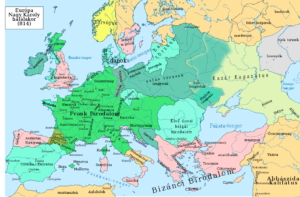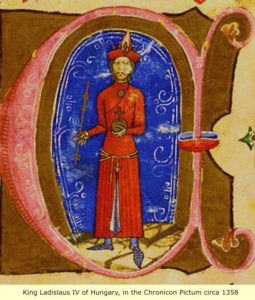Who were the Hungarians?
Who were the Hungarians aka Magyars?
Let me tell you a few words about Hungarian history before the Ottoman wars:

Some general information must be told about the Hungarians so as to understand what made them outstanding among the European nations to be able to endure the 300-year-long pressure of the Ottoman Empire. Hungarians, like many other peoples, have many roots. Our culture embodies the characteristics of each ingredient. However, the research on the origin of Hungarians is still an ongoing process. There is a debate about the origin which is going on. Sadly, it is being colored by political overtones.
The Avars, Onogurs, Huns…
Some historians claim that the Magyars were related to the remains of the Huns who appeared in the region around 375 AD. They say that at least SOME of the Huns had spoken the same language as the Magyars if we accept that the Hun Empire engulfed many nomadic tribes.
Others say that the Magyar language was rather the now Turkic-speaking people and the Finns had formed their language on the basics of the Magyar language. Undoubtedly, the bulk of the Hungarian vocabulary is Uralic. According to a theory, the similarity between the Hungarian and Uralic languages may have developed in such a way that the Hungarian language used to be a mediating language among the peoples who later moved to the Uralic region. Thus, the Hungarian language was a lingua franca but linguistics cannot solve the question on its own.
Some of the names used for describing Hungarians, the tradition of origin, and the folk music treasure lead to the Turkish peoples of the steppes. Or vice-versa: the cultural heritage of the Turkic peoples lead them to the Hungarians. The Hungarian Székelys of Transylvania have a legend that says they are the descendants of Prince Csaba, son of the Hun Attila.
According to Professor Makkay János, the early Avars (the so-called “várkony” tribe) were related to the Huns and they were in the Carpathian Region in 568 AD. (Please, note that I use the Eastern name order for Hungarian names where family names come first.)
As for the Huns, Hungarians have always been proud of King Attila. After Attila’s death (453), the Hun Empire disintegrated and the Carpathian Basin became the home of Germanic peoples. The Germans were expelled by the Avars (568) under the leadership of Kaghan Baja who made the Hungarian Great Plain the center of their empire. Around 680, when the Bulgarian-Turkish Empire disintegrated, Onogurs (pre-Hungarians?) arrived on Avar land who already spoke Hungarian: they survived until the Magyar conquest. If only the conquerors had brought the Magyar language into the Carpathian Basin, their language would have disappeared just as soon as several conquering elites merged into the conquered Slavic population.
According to the theory of Professor László Gyula, it was a “double home-taking”. He proved linguistically and archeologically that the late-Avar population before the coming of the Magyar tribes in 895 AD spoke the same language as the newcomers. He says that the Avars arrived about 670 AD in the Carpathian Basin.
The Magyars

Hungarians call themselves „Magyar” but they had been called by several names before. They called themselves “Magyar” since the age of a Kutrigur (Onogur) -Hun ruler who lived around 530 AD, he was called Maugerisz in Greek. Then, the Megyer tribe gained power in the 9th century and became dominant in the conquest of the Carpathian Basin.
Having come from the Eurasian Steppes, the Hungarian aka the Magyar nation of Chief Árpád has preserved many unique customs from their formerly nomadic lifestyle, including the military traditions of light cavalry warfare.
Arriving from the East to the Carpathian Basin between 862 and 881 AD, we believe that by the middle of the 9th century the people of the Hungarian Grand Duchy of Etelköz (land around the Volga, the Don, or the Dnieper rivers) at least partially moved to the Carpathian Basin, led by Álmos and Árpád. Their troops entered through the Carpathians and from the direction of the Sava and the Lower Danube.

Later, the Magyars led many campaigns against the West. Some historians say that they were only mercenaries of different Western rulers while others think they were searching for the “treasure of Attila” that Charlemagne had taken from the Avar tribes. The Hungarian invasions of Europe (German: Ungarneinfälle) took place in the ninth and tenth centuries, the period of transition in the history of Europe in the Early Middle Ages when the territory of the former Carolingian Empire was threatened by invasion from multiple hostile forces, the Magyars from the east, the Vikings from the north and the Arabs from the south.

Some historians think that the development of the Holy German Empire took shape as a reaction against the Hungarian peril. Here you can learn more about these campaigns:
https://en.wikipedia.org/wiki/Hungarian_invasions_of_Europe
Hungarians, after embracing Christ in 1,000 AD
The Hungarians were converted to Christianity in the 11th century in 1,000 AD, slightly before the Schism (1054 A.D.) between the Eastern and the Western Church. Hungary had to balance always between the East and the West, just like the Croats who chose also the Roman Catholic faith instead of the Byzantine church.
Their location is all the more important because Hungarians are the easternmost Roman Catholic people of Europe, similar to the Polish. Being on the border led them to conflicts with the Byzantine Empire, and later on with its successors, the Ottomans.
Also, Hungarians are not Indo-European people so most of their habits, dresses, food, language and warfare were quite different from the neighboring German, Italian, Wallachian, and Slavic people. According to the latest research, even their Finno-Ugric origin is being debated but it has remained the one-million-dollar question.
Despite having been Christianized, the Holy Roman Empire did not welcome the „descendants of the Hunnish King Attila and the Avars” next to their border, either. They remembered the disastrous defeat they had suffered in 907 A.D. at Pozsony (Bratislava, Pressburg) and it kept the German armies away from Hungary for 120 years but later the Hungarians had to block many attacks coming from the west, too.

Being able to fight effectively against Western and Eastern-style armies required the development of a mixed Hungarian army which contained heavy and light cavalry at the same time. Hungarians had light and heavy horse archers and they were considered the best quality warriors in Europe. Neither the traditional Western mounted soldiers nor the infantrymen could resist the arrows of the Hungarians, let alone their centralized and very flexible warfare. However, all nomadic armies are very effective until they do not get hit by disciplined heavy cavalry in wet weather. The first Hungarian kings successfully included the heavily armored knights in their horse-archer army, and this was how they could successfully block the continuous attacks of the intruding Eastern tribes, the Cumans, or the Pechenegs.
Even the Mongolians got stuck here in Hungary, in 1241-42 albeit destroying half of the kingdom. According to the latest research, the Hungarians did not suffer as many losses as we had thought before.
After all, it was only Hungary from where the Mongols had to withdraw their troops when their new Khan was about to be elected.


After their retreat, Hungarian King Béla IV (lived 1206-1270) even had enough military power left to beat out the intruding Germans from the western counties of Hungary. Duke Frederick II of Austria had thought the Mongolian invasion was a good opportunity to overrun the weakened country but he was defeated at Pozsony (Bratislava, Pressburg) by King Béla IV. This king was the one who realized that the Eastern nomads could be stopped by fortifications quite effectively. We call him the „castle-builder” because he was the first ruler who began to build stone castles by the hundreds. Previously, it had been the king who had the right to build stone castles but during his realm, the number of private castles has increased to 60%.

The Cuman nation has also been settled in the middle of Hungary, they contributed to the king’s army with their Eastern horsemanship and warfare, not to mention the Hungarian Székely border guards of Transylvania who have also preserved much of the ancient nomadic tactics.
It was no wonder that the second Mongolian invasion in 1285 was received by a strong army of heavy knights and horse-archers who could retreat to stone castles when it was needed.

It was László IV aka Cuman László (lived 1262-1290) the king of the Hungarians at that time.
The attacking Tatars suffered such a series of defeats that their leader, Khan Talabuga, great-grandson of Khan Batu could flee only on foot which was a great shame as far as nomads are concerned.

As the Hungarian borders were safely guarded, there has been a steady and safe development inside the country after the Mongols left. When the first Ottoman raiders penetrated into the heart of the kingdom after 1526, they found huge wealth piled up by generations untouched by war for hundreds of years.
Dear Readers, I can only make this content available through small donations or by selling my books or T-shirts.
If you like my writings, please feel free to support me with a coffee here:
You can check out my books on Amazon or Draft2Digital, they are available in hardcover, paperback, or ebook:
https://www.amazon.com/dp/198020490X
or at https://books2read.com/b/boYd81


My work can also be followed and supported on Patreon: Become a Patron!http://Become a Patron!





